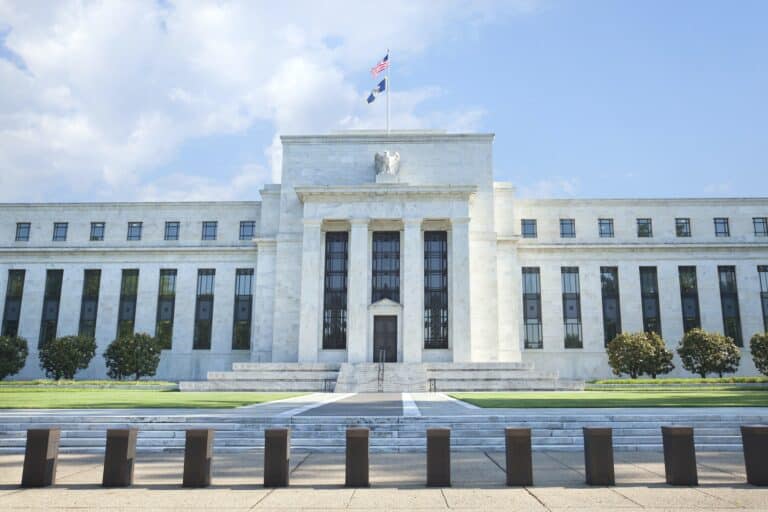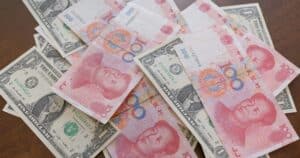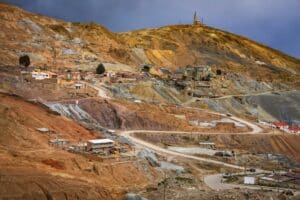Fractional Reserve Lending is the controversial banking model that drives the global financial system. Considered by many in the world of economics and finance to be a flawed system, at best, it essentially allows banks to create money out of thin air and then loan it out with interest attached.
You may be thinking, “No way that can be true.” Keep reading, and we’ll break down exactly how the fractional reserve lending system works.
Understanding Fractional Reserve Lending
As the world’s population and economy exploded in the early 1900s, the global financial system moved from asset-backed currencies to the fractional reserve system to give governments greater control over their money supply.
Under a fractional reserve system, a bank can lend money to customers against deposits they aren’t holding as long as they’re holding the “reserve requirement” in deposits.
For example, let’s imagine that the reserve requirement was set at 10%. This means that if a bank took in a deposit of $ 1 million from Customer A, they would be allowed to lend up to $900,000 of that deposit to Customer B.
On paper, Customer A still has $1,000,000 in deposits, Customer B has $900,000 in deposits, and the bank is now earning interest on the $900,000 they’ve basically created out of thin air.
Pretty crazy right? Well, that’s not all – the example above is based on a 10% reserve requirement. As of March 2020, the Federal Reserve Board has reduced the reserve requirements to 0%. This means that banks can lend up to 100% of their deposits – and people wonder why so many banks have collapsed in 2023.
Evolution And Current Practice
As absurd as it may sound, fractional reserve lending didn’t become the engine driving the global banking system by accident. This type of lending was crucial to keep up with the changes happening around the world in the 1920s and 1930s.
A more elastic money supply meant that banks could lend against future deposits to help businesses expand, spurring development and creating new industries. It also gave consumers easier access to credit as well as more things to buy with that credit, which helped the economy grow even faster.
While the fractional reserve system may make more sense from a theoretical point of view, it still depends entirely on the willingness of private banks to play by the rules. And as we have seen countless times over the past century or so, banks usually jump at the chance to bend, if not break, the rules if it means they’ll make a buck.
The Controversy Surrounding Fractional Reserve Lending
Critics’ main argument is that fractional-reserve lending is an inherently unstable system because it relies on the banking sector rather than actual capital reserves. This became very clear during the 2008 subprime crisis when overzealous lending policies forced banks to hold large amounts of bad debt.
On the other hand, proponents argue that reserve lending promotes economic growth and stability by allowing individuals to buy homes and cars and businesses to borrow money to invest in equipment, hire more employees, and expand operations.
To better understand the implications, let us take a closer look at the pros and cons of reserve lending.
| Pros | Cons |
| Fractional Reserve Lending increases the money supply and stimulates growth by giving businesses and consumers more access to credit. | This system can lead to fluctuations in the money supply, which can lead to inflation, recessions, or even depression. |
| By lending out a portion of depositors’ funds, banks create liquidity that allows for more transactions and easier movement of money within the economy. | In a fractional reserve system, banks hold only a fraction of deposits in reserve, which means they may not have enough liquid assets to handle many withdrawals at once. This can lead to bank runs and financial panics. |
| Banks earn interest on loans, which contributes to their profitability and allows them to offer additional financial services such as investment and wealth management options. | Fractional reserve lending could tempt banks to take excessive risks, knowing that the central bank or government is likely to intervene in times of crisis to prevent a systemic collapse. |
| The fractional reserve system allows the Federal Reserve to control the money supply and influence interest rates, which helps it maintain price stability and full employment. | Critics argue that fractional reserve lending can disproportionately benefit wealthier individuals and large corporations, exacerbating income inequality and financial crises. |
The Federal Reserve’s Role In Fractional Reserve Lending
Central banks are responsible for implementing policies that guarantee that banks hold enough reserves to cover potential losses. They also control the money supply to prevent runaway inflation or deflation. In the United States, our central bank is called The Federal Reserve.
The following are some of the policies and tools the Fed uses to regulate fractional-reserve lending and control the money supply in the economy:
- The Federal Reserve can buy or sell Treasury securities in the open market to increase or decrease the money supply. When the Fed buys securities, it injects money into the economy, which can boost growth. When it sells securities, it withdraws money from the economy, which slows inflation.
- It can require banks to hold a certain percentage of their deposits as reserves, limiting the amount of money lent. By raising or lowering reserve requirements, the Fed can control the amount of money available for banks to lend.
- The Fed can adjust the discount rate, the interest rate it charges banks for short-term loans. Raising or lowering the discount rate can affect the amount of money that banks borrow and lend.
- The Fed can signal its future monetary policy intentions through forward guidance. By communicating its plans to the public, the Fed can influence the expectations and behavior of consumers, businesses, and investors.
- Using quantitative easing, it can buy long-term securities or other assets to pump money into the economy. This can spur growth and increase the money supply.
- The Fed can pay interest on reserves held by banks to give banks an incentive to keep their excess reserves instead of lending them out. This can help control the money supply and limit inflation.
The Federal Reserve plays a key role in managing these risks through regulation, supervision, and monetary policy adjustments. Nevertheless, it’s important for individuals to be aware of the potential impact on their finances when making investment and credit decisions.
Alternatives To Fractional Reserve Lending
If fractional reserve lending has so many potential risks, why is it used? For the most part, because there are no real alternatives capable of sustaining the global economy in a safe manner-at least not at the moment. Here are a few options that are discussed as theoretical alternatives.
Direct Government Spending
Proponents of direct government spending as an alternative to fractional reserve lending believe that it offers several key advantages for promoting economic stability and growth. A key benefit is the reduction of the risk of financial instability associated with bank lending, such as a run on banks or widespread loan defaults. By allowing governments to create and issue money directly, the money supply would no longer be dependent on bank lending, which could lead to excessive risk-taking and financial crises.
Another advantage of direct government spending is that it can be more targeted to specific sectors of the economy that need investment or support. This targeted approach can lead to a more equitable distribution of resources and help reduce income inequality. For example, governments could invest in infrastructure projects, education, or health care to create jobs and spur economic growth in areas not reached through bank lending alone. By focusing on these sectors, governments can ensure that the benefits of economic growth are distributed more evenly across the population, meeting societal needs and promoting a more inclusive economy.
Direct government spending can also give governments and central banks more control over the money supply, enabling more effective implementation of monetary and fiscal policy. In times of economic downturns or recessions, central banks can use this control to increase government spending, stimulating demand and helping lift the economy from a slump. Conversely, during periods of strong economic growth and potential inflationary pressures, governments can tighten spending to maintain price stability. This direct control could lead to more efficient policy responses in addressing economic challenges compared to relying on the indirect effects of fractional reserve lending.
Full-Reserve Banking
Full-reserve banking is an alternative to fractional lending that has been proposed by some economists as a way to create a more stable and transparent banking system. In a full-reserve system, banks would be required to hold 100% of their deposits in reserve, meaning that they couldn’t lend more money than they had available.
One possible advantage is greater stability and transparency in the banking system. With a full reserve bank, depositors would have the assurance that their money is safe and can be withdrawn at any time since banks cannot use their deposits for lending. Investors would be less confused about lending practices because they could see exactly how much money a bank has on hand and how much it has lent.
Critics of the full-reserve system argue, however, that implementing such a system could slow economic growth and lead to less availability of credit for individuals and businesses. Since banks wouldn’t be able to lend more money than they actually have on hand, the supply of credit to borrowers would be limited, making it more difficult for individuals and businesses to obtain credit. Some also argue that full-reserve banking could lead to higher fees for depositors because banks could no longer make as much money from lending.
Public Banking
Another alternative that has attracted attention in recent years is the concept of public banks. Public banks are owned by state or local governments and operate for the benefit of their communities. Proponents of public banking argue that these institutions can help create stable, locally controlled sources of credit that aren’t subject to the same risks and influences as commercial banks.
One notable success story in public banking is the Bank of North Dakota (BND). Founded in 1919, BND is the only state-owned bank in the United States and provides financial services to state and local governments, businesses, and individuals. Because BND isn’t a commercial bank, it doesn’t accept deposits from citizens but instead uses funds from state taxes and fees to invest in local projects and make low-interest loans to businesses and individuals.
During the 2008 financial crisis, BND played a critical role in stabilizing North Dakota’s economy, which was one of the few states to experience positive growth during the recession. The bank made loans to struggling businesses and helped finance infrastructure projects that created jobs and spurred growth.
Proponents of public banking point to the success of BND as evidence of the potential benefits of this model. Because they operate independently of Wall Street and other commercial banks, public banks can focus on providing affordable credit to their communities, spurring economic development. They also argue that public banks can be more transparent and accountable than commercial banks because they’re owned and operated by the public.
Digital Currencies
Digital currencies, particularly cryptocurrencies, have emerged as potential alternatives to fractional reserve lending. Cryptocurrencies such as Bitcoin and Ethereum operate on decentralized networks, meaning they exist independently of central authorities such as banks or governments.
Lending would work similarly to traditional banking methods. Borrowers would still apply for a loan, and lenders would check the creditworthiness of potential borrowers. However, because digital currencies are decentralized, there’s less risk of instability from bad actors manipulating the system.
Digital currencies are transparent, and all transactions can be tracked on the blockchain – a public ledger – making it easier for lenders to verify that borrowers have sufficient funds to cover their loan payments, reducing the risk of fraud. Because transaction times are shorter and fees are lower with digital currencies, lenders may be able to offer more favorable lending rates.
These currencies offer unique opportunities to investors looking to diversify their portfolios beyond traditional options like stocks and bonds. However, the volatility of cryptocurrency markets requires careful consideration before making an investment decision.
Gold-Backed Currencies
Before fractional reserve lending, most of the world’s currencies were backed by gold. Gold was a good alternative because it’s a physical asset with a fixed supply, so its value is determined by demand.
Tying the value of a currency to a tangible asset like gold gives a currency more stability, which in turn increases the confidence of those who use the currency. While backing currencies with precious metals might make perfect sense in theory, in practice, it would be impossible to support the global economy at its current level due to limited supply.
Just because backing money with precious metals isn’t feasible on a global scale doesn’t mean that gold-backed currencies are completely off the table. In the United States, for example, a number of states are beginning to experiment with gold-backed currency at the state level. In addition, there have also been rumors about countries like China & Russia also exploring the potential for gold-backed currencies.
Whether or not a gold-backed currency will ever be a viable option for storing your wealth, investing in physical gold, such as gold coins and gold bars, offers almost all of the same benefits.
Break Your Dependence On Fiat Currencies With Gold
If you’d like to learn more about how you can diversify your portfolio by shifting some of your assets into precious metals, we’d be happy to answer any questions you may have.
Whether you want to buy physical gold to store at home or save for retirement in a gold-backed IRA, Noble Gold Investments has a range of options for investors at every stage of their journey.
Call Noble Gold Investments today at 877-646-5347 to speak with one of our account managers, or click here to open your account now.







